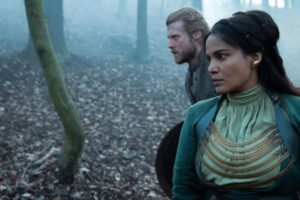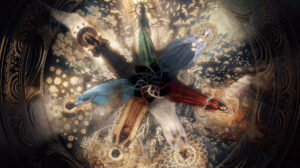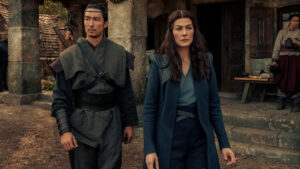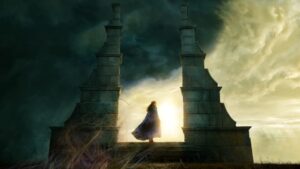SPOILERS FOR THE WHEEL OF TIME EPISODE FOUR AHEAD!
In the age of streaming television and the controversial “skip intro” button that allows audiences to jump straight into the action of their favorite shows, opening credits sequences are increasingly seen as a vanity – which is how they’ve managed to stick around at all, because they’re almost always strikingly beautiful or creative. But as more and more fantasy streaming series’ in particular forego the opening credits sequence entirely (looking at you, Shadow And Bone and The Witcher), The Wheel Of Time obviously stands out as an exception to this rule.

And I suppose that’s why Amazon Prime’s adaptation of Robert Jordan’s sprawling fourteen-book fantasy has drawn ire from some fans of HBO’s Game Of Thrones, who feel that the opening credits sequences of the two shows have too many similarities to be purely coincidental. Perhaps you could argue that both Wheel Of Time and Game Of Thrones‘ opening credits depict something being constructed, but I see that as an obtuse surface-level reading of both series’ opening credits sequences, as illogical as if you were to say that the two are identical because they share the word “of” in their titles.
The opening credits for both these series’ are more than just pretty animation; they’re an extension of their individual themes. For instance, Game Of Thrones‘ opening credits play over a montage of tiny little mechanical castles and fortresses springing up across the map of Westeros, itself revealed to be nothing more than an elaborate gameboard on which humans play out their power fantasies through artifice and intrigue. But Wheel Of Time‘s opening credits illustrate the story of the gender divide that is central to the series’ worldbuilding and magic system.
That’s why I’ve held off on even talking about the opening credits sequence in my reviews of the first three episodes, because only in episode four does The Wheel Of Time dive into the complex subject of the gender divide, and its consequences on gender roles and gender expression in this world. The episode and its opening credits are thematically intertwined almost as firmly as any of the threads that make up the vast cosmic tapestry being woven in the background while the credits play.
This tapestry starts its journey as a single white cord comprised of many threads, representing the One Power – the magical energy that permeates the world of The Wheel Of Time. In the books, the act of reaching into the One Power, absorbing it into oneself, and expelling or redirecting it is known as “channeling”, and people capable of doing so are called “channelers”, emphasizing that they are in fact merely conduits of a power which flows through them but does not belong to them or derive from them, and can easily destroy their fragile bodies.
This concept has been translated into live-action very literally, with Rosamund Pike’s physical performance as Moiraine Damodred in particular capturing the strength, dexterity, and above all vulnerability required of a powerful channeler in this world. Pike is almost always in motion, her body bending and limbs snaking swiftly yet purposefully as if allowing the One Power to flow directly through her towards her targets without giving it time to build up inside her and potentially burn her to a crisp.
We actually see one Aes Sedai sorceress, Liandrin (Kate Fleetwood) of the Red Ajah, come dangerously close to spontaneously combusting in this episode. The One Power burns beneath her skin and in her veins, and all the while more and more strands of magic are flowing into Liandrin’s body; too many for her to absorb and dispel simultaneously. In Jordan’s books, these strands are frequently described as “threads”, and magical constructs built from threads are known as “weaves”. Powerful channelers like Moiraine can wield many threads at once and build elaborate weaves.
Weaving and textile-work is often used in The Wheel Of Time as a metaphor for channeling and other uses of the One Power. Even the titular Wheel is a spinning-wheel which relies upon the One Power to continue endlessly rotating, weaving people and events into the inconceivable Pattern of human history over and over for all eternity. But if that all seems fairly straightforward, this is the part where Robert Jordan suddenly superimposes a rigid gender binary over his magic system, and things get…complicated.
Because Jordan’s fantasy mythology is heavily reliant on dualism, it’s no surprise that the One Power has two halves, which correspond to the nebulous concepts of masculinity and femininity. Jordan really went the extra mile, however, when he decided that men can only access the male half of the One Power (known as saidin) and women can only access the female half (known as saidar). Saidin and saidar are intended to exist in a symbiotic relationship, each challenging and complementing the other but both required to keep the One Power healthy and the Wheel of Time turning.
The show appears to be keeping that concept, but doing away with some of the bizarre rules that Jordan worked into his magic system. Not content with giving men and women two separate forms of magic to use, Jordan was also annoyingly insistent that women can only channel by surrendering themselves to the One Power, while men channel by forcefully taking the One Power. Get it, because, like, women are submissive and men are dominant, right? If we could take that whole concept and throw it in the garbage where it belongs, and then set the trash bin on fire, I wouldn’t be opposed.
Anyway…in the books, men and women were both able to channel until a couple thousand years before the events of the story, when the Dark One permanently tainted saidin so that men couldn’t access it without going mad, even generations later. We see this taint spreading up the rope representing the One Power in Wheel Of Time‘s opening credits before the cord splits into two halves, one white, the other dyed black. The question of where people outside the gender binary fit into this situation has yet to be answered satisfactorily.
The consequences of the rift are visible throughout Amazon’s series, from the very first scene onwards. By the time the story opens, the order of Aes Sedai, which once accepted both men and women into its ranks of channelers, has become an all-female organization with entire subdivisions dedicated to eradicating male channelers. We’re told upfront that the women of the Aes Sedai rule the world and protect it with the One Power, but new fans will have become increasingly aware that that is not the case, and that the reality is…a mess, honestly.
And in episode four, our close focus on Logain Ablar (Álvaro Morte) allows us to go deeper into the messiness and complexity of that situation as we follow his meteoric journey. Even though Logain is only able to channel aggressive tentacles of blackened, decaying saidin that whisper threats and taunts in his ears, the world in which he lives, in which he can declare himself the Dragon Reborn without any proof and win allies in his rebellion against the Aes Sedai from both the peasantry and nobility, is one that still revolves around the notion that men are meant to lead, regardless of whether they can channel without going mad – regardless of whether they can channel or not.
I don’t think The Wheel Of Time wants us to view Logain as a misogynist, to be clear. He does imply at one point that the Aes Sedai are supposed to follow him, but that’s because he’s totally confident in his assumption that he’s the Dragon Reborn – which makes his epiphany at the end of the episode that he’s not the Dragon hurt all the more, because it truly shakes him to his core. It’s only after that, in episode six, that he resorts to overt sexism, and even then it’s in a desperate attempt to provoke the Aes Sedai into killing him. It’s infinitely more interesting to see Logain as a tragic figure buffeted by forces beyond his control.
Because outside of Tar Valon, patriarchal systems of government and society are still alive and well in this world, and the One Power wielded by the Aes Sedai doesn’t necessarily translate into political power. In that respect, and also in their pomp and pageantry, the Aes Sedai are The Wheel Of Time‘s rough equivalent to the medieval Catholic Church (an amusing parallel, given that the latter institution has for centuries exalted one woman as being above all other saints in heaven while oppressing them on earth). The semi-divine authority that the Aes Sedai claim to possess over the entire world is similarly theoretical and dependent on tradition.
The effortlessness with which Logain accumulates followers and support is therefore unsurprising. He’s irresistibly charming and incredibly powerful, of course, but one gets the sense that it wouldn’t matter if he were neither of those things, because as Logain himself acknowledges later, men across the world are looking for any opportunity to test the limits of Aes Sedai power. Logain is merely a weapon of the old patriarchy trying to reassert itself, a shield behind which its true objective could be masked. That the Aes Sedai themselves are hardly a “good” organization muddies the waters significantly.

We saw hints of that way back in the cold open for episode one, when Liandrin led a pack of her Red Ajah sisters in a literal man-hunt to find a male channeler and “gentle” him. “Gentling”, the process of removing a man’s ability to channel, is depicted in this episode as violent and torturous – there’s nothing gentle about it. As we learn from Thom Merrilin (Alexandre Willaume) when he recounts the story of his nephew who was gentled by the Red Ajah, and as we later see evidenced in the hollowness of Morte’s Logain after his own gentling, men stripped of their ability to channel are almost always shattered by the experience.
The parallels between gentling (and its equivalent for female channelers, “stilling”) and the heinous real-world practice of conversion therapy for LGBTQ+ people are unmistakable. And throughout this episode, as Thom and Rand al’Thor (Josha Stradowski) struggle to help Mat Cauthon (Barney Harris) through the fear and loneliness of even potentially being able to channel, the language they use seems to intentionally play on the idea that the experience of being a male channeler in The Wheel Of Time is vaguely akin to the real-world experiences of many queer people, particularly in oppressive religious environments.
Showrunner Rafe Judkins, himself a gay man raised in a Mormon community, wisely balances out these instances of queer-coded metaphor with substantial queer representation. Following the casual confirmation in episode three that there are no social stigmas attached to same-sex relationships throughout most of this world, the show has a responsibility to show that onscreen – and in episode four, we’re introduced to Maksim (Taylor Napier) and Ihvon (Emmanuel Imani), a pair of queer Warders who love each other as deeply as they love the third member of their polyamorous trio, the Aes Sedai Alanna Mosvani (Priyanka Bose).
Examining the sacred bond between an Aes Sedai and their Warder(s) proves to be a large part of both this episode and the next. People tied together by the bond become true soulmates, gaining an almost telepathic ability to communicate their thoughts and emotions from one to the other – thereby allowing them to bridge them the gender divide of their world. For some, the partnership is completely platonic, as is the case with Moiraine and her Warder, Lan Mandragoran (Daniel Henney). For others, it’s romantic and/or sexual. But on every level, the bond increases a person’s capacity for love and empathy.
Of the two groups, however, the Warders clearly receive more love from a screenplay that favors their perspective on Aes Sedai teachings and practices to those of the Aes Sedai themselves. Through Nynaeve al’Meara (Zoë Robins), whose animosity with Lan in the previous episode is quickly developing into mutual curiosity and affection, we’re invited to spend time with the Warders around their campfire as they idly chit-chat and share stories. And it’s through the raw grief of the Warder Stepin (Peter Franzén) that we experience for the first time the severing of the bond after his Aes Sedai, Kerene Nagashi (Clare Perkins) is killed by Logain.
This choice would make more sense to me if the Warders were depicted as clearly the more relatable of the two groups, and the Aes Sedai as enigmatic and aloof as they were typically shown in the books – or even in The Wheel Of Time‘s opening credits sequence, where the tapestry being woven slowly resolves itself into an image of seven women arranged after the seven spokes of the Wheel of Time, representing the seven color-coded Ajahs of the Aes Sedai. But that sequence promises a mystique and magnificence that I feel we don’t quite get from the Aes Sedai in episode four, and even thereafter only see in quick glimpses.
Of course, there’s the caveat that the group of Aes Sedai we meet in episode four have been on the road for months, and are worn down by the exhaustion of trying to hold Logain captive without gentling him. But it’s harder to feel the effects of that mental and physical toll when we’ve barely gotten a chance to admire the full power and glory of the Aes Sedai – even Moiraine, awesome as she was in the battle of Emond’s Field, spent a fair amount of episode two and all of episode three wavering on the edge of unconsciousness after a single injury sustained in that fight.
And then there’s the costumes. I haven’t been impressed by many of the costumes on this show, but the Aes Sedai in particular were a missed opportunity to flaunt Amazon’s big budget with luxurious fabrics, unique textures and patterns, stylish cuts, and priceless jewelry. Even taking into account that they’re traveling, the Aes Sedai are always keenly aware of their image outside of Tar Valon for reasons I think I made clear above – what they lack in political power, they make up for with their influence. Look to the Catholic Church, and there’s a richness and brilliance to the traditional papal vestments that is designed to inspire awe.
But in the show, outside of a few stylish leather pieces like Liandrin’s knee-high boots and accessories like Moiraine’s shoulder-pads, the costume design is severely lacking when it comes to accentuating any sense of ostentatiousness or grandiosity that the Aes Sedai are supposed to have cultivated around themselves. Alanna’s costume perhaps comes closest to achieving a balance between practicality (which, for a member of the Green Ajah, is a top priority) and showiness (a little gold ornamentation here and there, nothing too outlandish really), but the rest are just…drab.
This lack of synchronization between the costumes and the characters wearing them is exacerbated by the overly bright lighting, which continues to be a major problem for this show but here really gets into every nook and cranny of the spotless soundstage that serves as the Aes Sedai camp, exposing just how little effort has gone into making this look like a lived-in environment with dirt and grime and wear. There are moments, particularly during action scenes, when the camp looks like a bad cosplay convention or an overly polished historical reenactment.
But if the Aes Sedai are lacking any depth and substance to their costumes, the far greater problem is that their subplot throughout this episode is itself devoid of much nuance. After being warned by Moiraine that Aes Sedai are master manipulators each with their own hidden agenda, we’re introduced to a group of Aes Sedai whose motives are shallow and obvious, and whose schemes are only half-baked. How much more compelling would Liandrin be as a villain if, instead of openly voicing her desire to gentle Logain, she only subtly encouraged debate of the topic and allowed others to prove her points for her?
For our introduction to the Aes Sedai, that weak writing coupled with poor costuming threatens to tear apart the tapestry so carefully constructed in the opening credits, but there are moments that save this episode for me. Balancing the badly-lit battle between the Aes Sedai and Logain’s army is a duel between Thom Merrilin and a Myrddraal that, while significantly shorter, is so up-close and personal that you can’t help but shudder in admiration for the practical effects used to achieve the Myrddraal’s hideous physical presence. Balancing the weak emotional impact of Kerene’s death is the pain and horror we feel from Nynaeve when she thinks she’s lost Lan.
(Without getting into spoilers for the books and presumably the season one finale, there’s not much I can really say about the incredible power display from Nynaeve at the end of this episode except that…well, it’s incredible. I think there are as many downsides as there are upsides to prolonging the mystery of the Dragon Reborn’s identity, and I hope new fans are allowed in on the big secret soon so we can all theorize together).

So while I can’t say that I loved this episode, it’s still very enjoyable and is interspersed with enough excellent scenes and heartfelt character moments to warrant just as much praise as criticism. Director Wayne Che Yip again delivers a thematically rich story that draws upon Robert Jordan’s fantasy cosmology and theology for inspiration, and if it’s less bold with regards to gender than episode three was with morality, it still has fun tinkering with the rules that Jordan laid out for his world and improving upon his dated representation.
Episode Rating: 7.5/10








